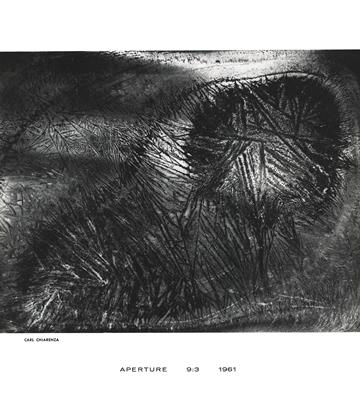WYNN BULLOCK
In Bullock’s photograph, Print 15, the redwood is dead, the horsetails live on, as symbols of the force of life and the feeding of life by what dies. The horsetail of paleolithic time was bigger than the redwood. This is the kind of message to read from Bullock—an enigmatic gazing at objects seen merely at one selected intersection of their time. Geologic time, in which all natures, human and otherwise, are symbiotic. The photographs are not 'literary,’ or are so very rarely. For years the photographer had travelled Highway 1 below Carmel Highlands and been aware of the erosion in Print 14. Suddenly it became 'an event,’ and suddenly the figurations of the soil became related to a procession of hooded monks. It is thus that metaphor clothes the world in visually interesting ways and humanizes mysteries. One sees visions. The child’s wonderments in Prints 13 and 18 are fascinating but very frightening—something more than the preternatural light in the heads of the weeds and on the branches of the oaks. The thistle in Print 17 is as 'important’ as the nude figure. The impingement of natures, mixed beyond measure, is felt, connoted perfectly. And what of the person whose chair is charred in Print 16? The quality in the photograph is simply the event of fire, and no document of tragedy. Yet it is not so simple. Your cat brings in a half-dead bird and deposits it coolly next to the piano. So, do something! Kill it, rush it to the vet, scold or compliment your cat on being a cat, cogitate on the ascending orders of reality, or breathe a little easier for the safety of the click beetle on the daphne bush within easy range of all sparrows. "One has the choice of emphasizing any one of the dimensions. However I feel very strongly that all photographers interested in creative expression should be consciously aware that these dimensions are a measure of reality and their dimensional progression is a law of nature. Whether one wishes to express fantasy or reality the principle expressed is needed as a reference point for whatever creative direction one wishes to take. This is not an intellectual device but an understanding to aid our perceptual seeing in photography.” Thus Bullock puts it in discussing the four dimensions. Which brings us exactly back to Henry James, and let us agree with his conclusion: "It came back again—it was always, after this fashion, coming back, as if to make me extravagantly repeat myself—to the quantity to be 'read into’ the American view, in general, before it gives out an interest. The observer, like a fond investor, must spend on it, boldly, ingeniously, to make it pay; and it may often thus remind one of the wonderful soil of California, which is nothing when left to itself and the fine weather, but becomes everything conceivable under the rainfall.”

















